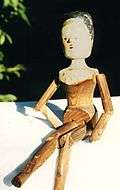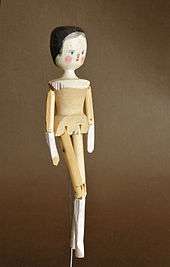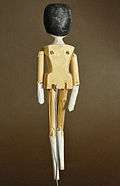Peg wooden doll

Peg wooden dolls, also known as Dutch dolls, are a type of wooden doll from the Netherlands and Germany. They originated as simple lathe-turned dolls from the Val Gardena in the Alps.[1] These dolls were sold undressed. Children would then make their clothing from scraps of fabric.
Other similarly constructed wooden dolls, using a jointing technique where the arms and/or legs are attached to the body with pegs, are some of the oldest surviving dolls, and were made worldwide. Sometimes a peg wooden doll's arms or legs are locked together by the jointing system, so if one arm is moved the other will move. An advanced form of peg joints is where the body pegs are "split" and attached separately allowing independent movement.
Tuck comb dolls are a special style of peg wooden doll, named for their carved hair comb. The head and body is turned as one piece. The hair is usually painted with curled fringes and with a painted comb. Early tuck comb dolls had elongated, graceful proportions, nicely carved details, painted slippers, and sometimes with wood pendant earrings. Some dressed as merchants were called pedlar dolls.
Florence Kate Upton illustrated a children's book entitled The Adventures of Two Dutch Dolls and a Golliwogg.[2]
The Museum Gherdëina has a collection of Dutch dolls of different sizes.
Gallery
 Peg wooden doll from Val Gardena, late 19th century
Peg wooden doll from Val Gardena, late 19th century Peg wooden doll from Val Gardena, late 19th century
Peg wooden doll from Val Gardena, late 19th century- Peg wooden doll from Val Gardena, late 19th century
 Peg wooden doll from Val Gardena, late 19th century
Peg wooden doll from Val Gardena, late 19th century Peg wooden doll from Val Gardena, late 19th century, rear view
Peg wooden doll from Val Gardena, late 19th century, rear view
See also
- Night Terrors (Doctor Who), which features life-sized peg dolls as monsters
References
- ↑ Rita Stäblein, Robert Moroder: Toy manufacture as a cottage Industry in old Gröden. Museum Gherdëina, Urtijëi, 1994.
- ↑ The Project Gutenberg EBook of The Adventure of Two Dutch Dolls and a Golliwogg, by Bertha Upton
| Wikimedia Commons has media related to Dutch dolls. |